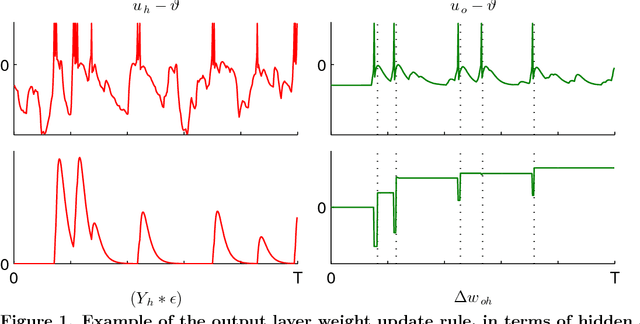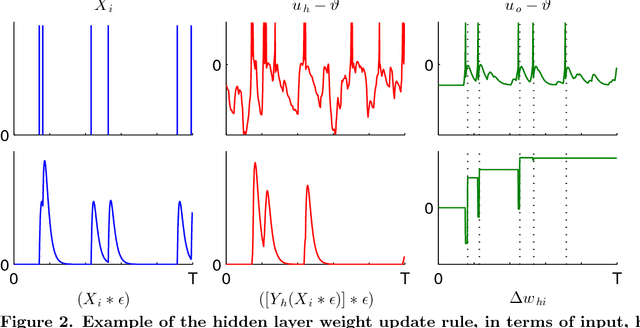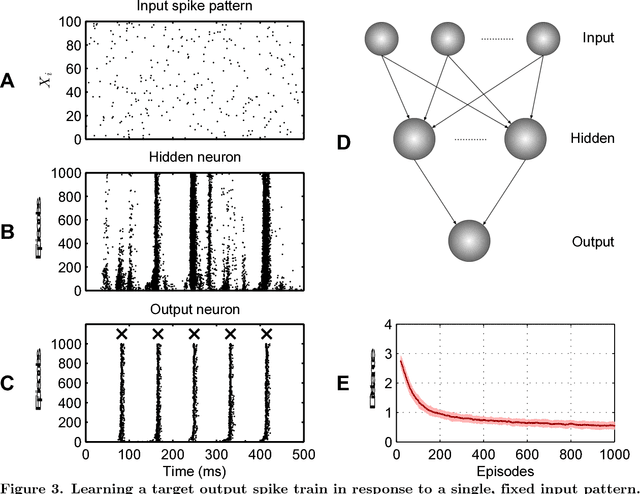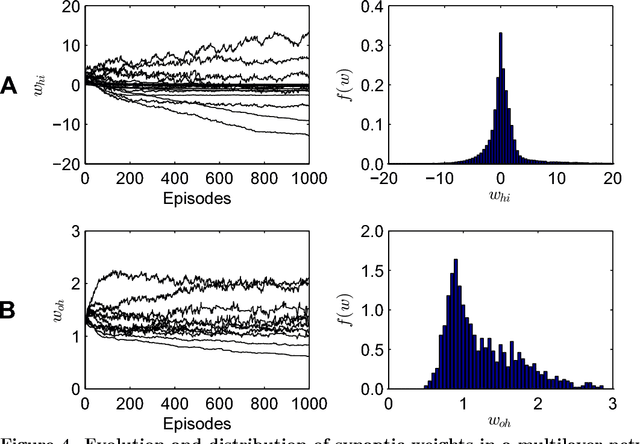Ioana Sporea
Encoding Spike Patterns in Multilayer Spiking Neural Networks
Mar 31, 2015



Abstract:Information encoding in the nervous system is supported through the precise spike-timings of neurons; however, an understanding of the underlying processes by which such representations are formed in the first place remains unclear. Here we examine how networks of spiking neurons can learn to encode for input patterns using a fully temporal coding scheme. To this end, we introduce a learning rule for spiking networks containing hidden neurons which optimizes the likelihood of generating desired output spiking patterns. We show the proposed learning rule allows for a large number of accurate input-output spike pattern mappings to be learnt, which outperforms other existing learning rules for spiking neural networks: both in the number of mappings that can be learnt as well as the complexity of spike train encodings that can be utilised. The learning rule is successful even in the presence of input noise, is demonstrated to solve the linearly non-separable XOR computation and generalizes well on an example dataset. We further present a biologically plausible implementation of backpropagated learning in multilayer spiking networks, and discuss the neural mechanisms that might underlie its function. Our approach contributes both to a systematic understanding of how pattern encodings might take place in the nervous system, and a learning rule that displays strong technical capability.
Supervised Learning in Multilayer Spiking Neural Networks
Feb 10, 2012Abstract:The current article introduces a supervised learning algorithm for multilayer spiking neural networks. The algorithm presented here overcomes some limitations of existing learning algorithms as it can be applied to neurons firing multiple spikes and it can in principle be applied to any linearisable neuron model. The algorithm is applied successfully to various benchmarks, such as the XOR problem and the Iris data set, as well as complex classifications problems. The simulations also show the flexibility of this supervised learning algorithm which permits different encodings of the spike timing patterns, including precise spike trains encoding.
* 38 pages, 4 figures
Supervised Learning of Logical Operations in Layered Spiking Neural Networks with Spike Train Encoding
Dec 01, 2011



Abstract:Few algorithms for supervised training of spiking neural networks exist that can deal with patterns of multiple spikes, and their computational properties are largely unexplored. We demonstrate in a set of simulations that the ReSuMe learning algorithm can be successfully applied to layered neural networks. Input and output patterns are encoded as spike trains of multiple precisely timed spikes, and the network learns to transform the input trains into target output trains. This is done by combining the ReSuMe learning algorithm with multiplicative scaling of the connections of downstream neurons. We show in particular that layered networks with one hidden layer can learn the basic logical operations, including Exclusive-Or, while networks without hidden layer cannot, mirroring an analogous result for layered networks of rate neurons. While supervised learning in spiking neural networks is not yet fit for technical purposes, exploring computational properties of spiking neural networks advances our understanding of how computations can be done with spike trains.
* 15 pages, 4 figures
 Add to Chrome
Add to Chrome Add to Firefox
Add to Firefox Add to Edge
Add to Edge